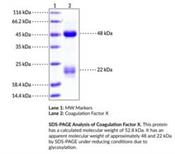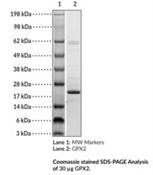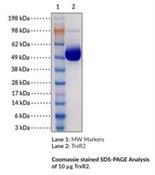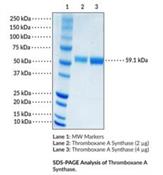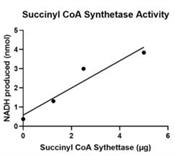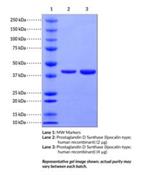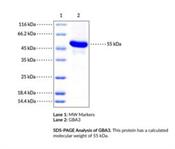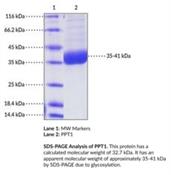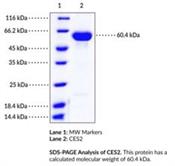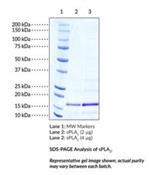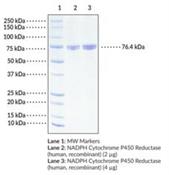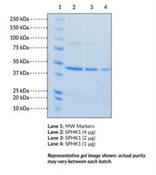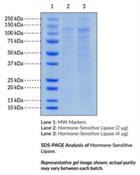Get your Research Moving with Pure Human Recombinant Enzymes. Certainly! Recombinant DNA technology is a powerful tool in molecular biology. It allows scientists to manipulate DNA fragments for research purposes. Enzymes are organic molecules that act as catalysts for chemical reactions. They play a fundamental role in various scientific research areas.
$320.00
Coagulation Factor X
(human, recombinant)
Synonyms: Factor 10
Factor X
FX
Stuart Factor
Stuart-Prower
Factor
Factor X
FX
Stuart Factor
Stuart-Prower
Factor
Purity: ≥97% by SDS-PAGE
Amino Acids: 1-488
MW: 52.8 kDa
MW: 52.8 kDa
Formulation: Lyophilized from sterile 50 mM Tris, pH 8.0, 100 mM sodium chloride, and 10% glycerol
GPX2
(Human Recombinant)
Synonyms: Glutathione
Peroxidase 2
(Gastrointestinal)
GSHPX2
GSHPX-GI
Peroxidase 2
(Gastrointestinal)
GSHPX2
GSHPX-GI
Purity: ≥95% by SDS-PAGE
Formulation: 25 mM Tris-HCl, pH 8.0, with 250 mM sodium chloride, 2 mM 2-mercaptoethanol, and 10% glycerol
$510.00
Thioredoxin Reductase 2
(Human Recombinant)
Syns: NADPH-dependent
Thioredoxin
Reductase 2,
TrxR2, Txnrd2.
Thioredoxin
Reductase 2,
TrxR2, Txnrd2.
Purity: ≥95% by SDS-PAGE
Amino Acids: 488 residues
Formulation: TE buffer with 50% glycerol
$410.00
Thromboxane A Synthase
(Human Recombinant)
Syns: CYP5A1
Cytochrome P450 5A1
TBXAS1, TXAS,
TXA Synthase
Cytochrome P450 5A1
TBXAS1, TXAS,
TXA Synthase
Purity: ≥90% by SDS-PAGE
Amino Acids: 30-533 with a modified N-terminus and F-G loop
Formulation: 50 mM Tris, pH 7.4, with 5% glycerol, 0.2 mM DTT, and 0.2 mM
MW: 59.1 kDa
$779.00
Succinyl-CoA synthetase
Synonyms: SCS
Succinate Thiokinase
Succinyl Coenzyme A
Synthetase
Succinate Thiokinase
Succinyl Coenzyme A
Synthetase
Purity: ≥85% by SDS-PAGE
MW: 29.8 kDa (α), 41.4 kDa (β)
Formulation: 50 mM HEPES, pH 8.0, 150 mM sodium chloride, 20% glycerol
$220.00
GDP-L-Fucose Synthase (Human Recombinant)
Synonyms: Protein FX
Red Cell NADP(H)-Binding Protein, TSTA3
Red Cell NADP(H)-Binding Protein, TSTA3
Purity: ≥90% by SDS-PAGE
Amino Acids: 2-321
MW: 37.98 kDa
Formulation: 50 mM HEPES, pH 8.0, with 150 mM sodium chloride and 10% glycerol
$480.00
Prostaglandin D Synthase (lipocalin-type; mouse recombinant)
Synonyms: Lipocalin-PGDS
L-PGDS
L-PGDS
Purity: ≥90% by SDS-PAGE
MW: 46 kDa
Formulation: 50 mM sodium phosphate, pH 7.2, containing 20% glycerol, 150 mM sodium chloride, 1 mM DTT, and 0.5 mM EDTA
$590.00
100 µg
Prostaglandin D Synthase(lipocalin-type; human recombinant)
Synonyms: Lipocalin-PGDS
L-PGDS
L-PGDS
Purity: ≥85% by SDS-PAGE
MW: 46 kDa/subunit
Formulation: 50 mM sodium phosphate, pH 7.2, containing 20% glycerol, 150 mM sodium chloride, 1 mM DTT, and 0.5 mM EDTA
$480.00
GBA3
(Human Recombinant)
(Human Recombinant)
Synonyms:cBGL1
Cytosolic β-Glucosidase
Cytosolic β-Glucosidase-like Protein-1
Klotho-related Protein
KLrP
Cytosolic β-Glucosidase
Cytosolic β-Glucosidase-like Protein-1
Klotho-related Protein
KLrP
Purity: ≥90% by SDS-PAGE
MW: 55 kDa
Formulation: Lyophilized from sterile 20 mM Tris, 300 mM sodium chloride, pH 7.5, with 10% glycerol, 5% trehalose, 5% mannitol, and 0.01% tween-80
$410.00
sPLA2
recombinant type IIE
recombinant type IIE
Synonyms:GIIE sPLA2
Group IIE Secretory Phospholipase A2
Phosphatidylcholine 2-Acylhydrolase 2E
Phospholipase A2 Group IIE
sPLA2-IIE
Group IIE Secretory Phospholipase A2
Phosphatidylcholine 2-Acylhydrolase 2E
Phospholipase A2 Group IIE
sPLA2-IIE
Purity: ≥80% by SDS-PAGE
Amino Acids: 32-154
MW: 14 kDa
Formulation: 25 mM Tris, pH 7.5, with 100 mM potassium chloride and 10 mM calcium chloride
$290.00
PPT1
(Human Recombinant)
(Human Recombinant)
Synonyms:Palmitoyl-protein Hydrolase 1
Palmitoyl-protein Thioesterase 1, CLN1
Palmitoyl-protein Thioesterase 1, CLN1
Purity: ≥90% by SDS-PAGE
Amino Acids: 28-306
MW: 32.7 kDa
Formulation: Lyophilized from sterile PBS, pH 7.4
$250.00
Carboxylesterase 2 (CES2)
(Human Recombinant)
(Human Recombinant)
Synonyms:Carboxylesterase 2, CE-2, Cocaine Esterase
Methylumbelliferyl-acetate Deacetylase 2
Methylumbelliferyl-acetate Deacetylase 2
Purity: ≥95% by SDS-PAGE
Amino Acids: 27-559
MW: 60.4 kDa
Formulation: Lyophilized from sterile 50 mM sodium acetate, with 150 mM sodium chloride, and 10% glycerol, pH 5.5
$340.00
sPLA2
(human recombinant Type IID)
(human recombinant Type IID)
Synonyms: GIID sPLA2
Phospholipase A2 Group IID
PLA2G2D
PLA2IID
sPLA2-IID
Secretory Phospholipase A2 (Group IID)
Phospholipase A2 Group IID
PLA2G2D
PLA2IID
sPLA2-IID
Secretory Phospholipase A2 (Group IID)
Purity: ≥85% by SDS-PAGE
Amino Acids: 21-145
MW: 16.7 kDa
Formulation: 50 mM Tris, pH 8.0, 100 mM sodium chloride, 20 mM calcium chloride, 0.05% Triton X-100, and 10% glycerol
$300.00
NADPH Cytochrome P450 Reductase
(Human Recombinant)
(Human Recombinant)
Synonyms:
CPR, CYPOR NADPH Hemoprotein Reductase, NCPR, P450R, POR
CPR, CYPOR NADPH Hemoprotein Reductase, NCPR, P450R, POR
Purity: ≥90% by SDS-PAGE
Amino Acids: 24-677
MW: 76.4 kDa
Formulation: 50 mM potassium phosphate, pH 7.6, with 10% glycerol
$750.00
Sphingosine Kinase 1 (human recombinant)
Synonyms: SK1
SPHK1
SPHK1
Purity: ≥80% by SDS-PAGE
Source: Active human recombinant N-terminal His-tagged protein from Sf9 cells
MW: 47.5 kDa
Formulation: 25 mM HEPES, pH 8.0, with 150 mM sodium chloride, 3 mM DTT, 0.05% polysorbate 20, and 25% glycerol
$612.00
Hormone-Sensitive Lipase (Human Recombinant)
Synonyms: HSL
LIPE
LIPE
Source: Active recombinant N-terminal His-tagged protein, expressed in Sf21 insect cells using a baculovirus expression system
Amino Acids: 2-1,076 (full-length)
MW: 118.3 kDa
$430.00
About Enzymes:
Enzymes are very efficient and specific catalyst proteins which react with 1 or few types of substrates in biochemical reactions and are responsible for bringing about almost all of the chemical reactions in living organisms. Enzymes speed up reactions by providing an alternative reaction pathway of lower activation energy. Without enzymes, reactions take place at a rate far too slow for the pace of metabolism which means that they speed up the chemical reactions in living things.
There are 2 types of enzymes, ones that help join specific molecules together to form new molecules & others that help break specific molecules apart into separate molecules. Enzymes play many important roles ouside the cell as well. One of the best examples of this is the digestive system. For instance, it is enzymes in your digestive system that break food down in your digestive system break food down into small molecules that can be absorbed by the body. Some enzymes in your digestive system break down starch, some proteins and others break down fats. The enzymes used to digest our food are extra-cellular since they are located outside our cells & enzymes inside our cells are intra-cellular enzymes. Enzymes are used in ALL chemical reactions in living things; this includes respiration, photosynthesis, movement growth, getting rid of toxic chemicals in the liver and so on. Enzymes are proteins that must have the correct structure to be active. They are very easily affected by heat, pH and heavy metal ions.
Ribonucleoprotein enzyme catalytic activity is located in the protein part but for some the catalytic activity is in the RNA part. A catalyst is any substance which makes a chemical reaction go faster, without itself being changed. A catalyst can be used over and over again in a chemical reaction and does not get used up.
Enzymes lower the amount of activation energy needed by binding to the reactants of the reaction they catalyze, thus speed up the reaction and can process millions of molecules per second. Enzymes are typically large proteins with high molecular weight that permit reactions to go at conditions that the body can tolerate.
Enzyme nomenclature is based on what the enzyme reacts with & how it reacts along with the ending ase.
Enzymes must get over the activation energy hurdle.
Enzymes change how a reaction will proceed which reduces the activation energy and makes it faster. The more we increase the enzyme concentration the faster the reaction rate for non-catalyzed reactions. Enzymes that are catalyzed reactions also increase reaction rate at higher level of concentration but up to a certain point called Vmax which means that the enzyme has reached its maximum point. The reaction is limited by both the concentrations of the enzyme and substrate. Enzymes as catalysts take part in reactions which provide an alternative reaction pathway. Enzymes do not undergo permanent changes and remain unchanged at the end of the reaction. They only change the rate of reaction, not the position of the equilibrium.Enzymes as catalysts are highly selective by only catalysing specific reactions due to the shapes of the enzyme’s molecule.
Enzymes contain a globular protein part called apoenzyme and a non-protein part named cofactor or prosthetic group or metal-ion-activator. Changes in temperature and pH have great influence on the intra- and intermolecular bonds that hold the protein part in their secondary and tertiary structures.
Examples of cofactors are 1. Prosthetic group that are permanently bound to the enzyme. 2. Activator group which are cations (positively charged metal ions) & temporarily bind to the active site of the enzyme. 3.Coenzymes, usually vitamins or made from vitamins which are not permanently bound to the enzyme molecule, but combine with the enzyme-substrate complex temporarily. Enzymes require the presence cofactors before their catalytic activity can be exerted. This entire active complex is referred to as the holoenzyme.
Without enzymes, our guts would take weeks to digest our food, our muscles, nerves and bones would not work properly and so on…
All enzymes that catalyse oxido-reductions belong in this class. The substrate oxidized is regarded as a hydrogen or electron donor. The classification is based on 'donor:acceptor oxidoreductase'. The common name is 'dehydrogenase', wherever this is possible; as an alternative, 'acceptor reductase' can be used. 'Oxidase' is used only where O2 is an acceptor. Classification is difficult in some cases, because of the lack of specificity towards the acceptor.
Transferases are enzymes that transfer a group, for example, the methyl group or a glycosyl group, from one compound (generally regarded as donor) to another compound (generally regarded as acceptor). The classification is based on the scheme 'donor:acceptor grouptransferase'. The common names are normally formed as 'acceptor grouptransferase' or 'donor grouptransferase'. In many cases, the donor is a cofactor (coenzyme) that carries the group to be transferred. The aminotransferases constitute a special case.
These enzymes catalyse the hydrolysis of various bonds. Some of these enzymes pose problems because they have a very wide specificity, and it is not easy to decide if two preparations described by different authors are the same, or if they should be listed under different entries. While the systematic name always includes 'hydrolase', the common name is, in most cases, formed by the name of the substrate with the suffix -ase. It is understood that the name of the substrate with this suffix, and no other indicator, means a hydrolytic enzyme. It should be noted that peptidases have recommended names rather than common names.
Lyases are enzymes that cleave C-C, C-O, C-N and other bonds by means other than by hydrolysis or oxidation. They differ from other enzymes in that two (or more) substrates are involved in one reaction direction, but there is one compound fewer in the other direction. When acting on the single substrate, a molecule is eliminated and this generates either a new double bond or a new ring. The systematic name is formed according to 'substrate group-lyase'. In common names, expressions like decarboxylase, aldolase, etc. are used. 'Dehydratase' is used for those enzymes that eliminate water. In cases where the reverse reaction is the more important, or the only one to be demonstrated, 'synthase' may be used in the name.
Ligases are enzymes that catalyse the joining of two molecules with concomitant hydrolysis of the diphosphate bond in ATP or a similar triphosphate. 'Ligase' is often used for the common name, but, in a few cases, 'synthase' or 'carboxylase' is used. 'Synthetase' may be used in place of 'synthase' for enzymes in this class.
There are 2 types of enzymes, ones that help join specific molecules together to form new molecules & others that help break specific molecules apart into separate molecules. Enzymes play many important roles ouside the cell as well. One of the best examples of this is the digestive system. For instance, it is enzymes in your digestive system that break food down in your digestive system break food down into small molecules that can be absorbed by the body. Some enzymes in your digestive system break down starch, some proteins and others break down fats. The enzymes used to digest our food are extra-cellular since they are located outside our cells & enzymes inside our cells are intra-cellular enzymes. Enzymes are used in ALL chemical reactions in living things; this includes respiration, photosynthesis, movement growth, getting rid of toxic chemicals in the liver and so on. Enzymes are proteins that must have the correct structure to be active. They are very easily affected by heat, pH and heavy metal ions.
Enzymes lower the amount of activation energy needed by binding to the reactants of the reaction they catalyze, thus speed up the reaction and can process millions of molecules per second. Enzymes are typically large proteins with high molecular weight that permit reactions to go at conditions that the body can tolerate.
Enzyme nomenclature is based on what the enzyme reacts with & how it reacts along with the ending ase.
Enzymes must get over the activation energy hurdle.
Enzymes change how a reaction will proceed which reduces the activation energy and makes it faster. The more we increase the enzyme concentration the faster the reaction rate for non-catalyzed reactions. Enzymes that are catalyzed reactions also increase reaction rate at higher level of concentration but up to a certain point called Vmax which means that the enzyme has reached its maximum point. The reaction is limited by both the concentrations of the enzyme and substrate. Enzymes as catalysts take part in reactions which provide an alternative reaction pathway. Enzymes do not undergo permanent changes and remain unchanged at the end of the reaction. They only change the rate of reaction, not the position of the equilibrium.Enzymes as catalysts are highly selective by only catalysing specific reactions due to the shapes of the enzyme’s molecule.
Examples of cofactors are 1. Prosthetic group that are permanently bound to the enzyme. 2. Activator group which are cations (positively charged metal ions) & temporarily bind to the active site of the enzyme. 3.Coenzymes, usually vitamins or made from vitamins which are not permanently bound to the enzyme molecule, but combine with the enzyme-substrate complex temporarily. Enzymes require the presence cofactors before their catalytic activity can be exerted. This entire active complex is referred to as the holoenzyme.
Without enzymes, our guts would take weeks to digest our food, our muscles, nerves and bones would not work properly and so on…
Main Enzyme category groups:
Oxidoreductases:
Transferases:
Hydrolases:
Lyases:
Ligases:
Human Recombinant Enzymes
Shop online today, you won't
be disappointed!
be disappointed!
Quick Delivery
Our mission is to "delight our customers
with quick and convenient delivery, great prices and excellent customer service"
with quick and convenient delivery, great prices and excellent customer service"
Over 95% of orders are delivered within 1-3 working days.



© 2023 Eumenamedlimited.com. All Rights Reserved.
All products on this site are for Research, Development use only. Products are Not for Human consumption of any kind.
All products on this site are for Research, Development use only. Products are Not for Human consumption of any kind.
Amino Acids: 190 residues
